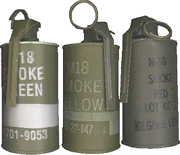When I became a radio-telephone operator, or RTO, I traded my M-60
machine gun ammo for a 25-pound steel box on my back. Each combat platoon had at
least three radios, or one per squad. A company sized group also had radios for
battalion communications and for the artillery forward observer.
 The PRC-25 radio was
battery-operated. The battery lasted about one day of continuous use, so I always
carried a spare strapped to the bottom of the case - another five or six pounds. The
radio had two large knobs on top which let us change the radio frequency. When we
operated near the Cambodian border we would change radio frequencies every day so that
enemy listening posts would not pick up our transmissions. On one three-day mission
we even attached encryption devices to scramble our radio calls - boxes almost as big as
the radios themselves, but very lightweight
The PRC-25 radio was
battery-operated. The battery lasted about one day of continuous use, so I always
carried a spare strapped to the bottom of the case - another five or six pounds. The
radio had two large knobs on top which let us change the radio frequency. When we
operated near the Cambodian border we would change radio frequencies every day so that
enemy listening posts would not pick up our transmissions. On one three-day mission
we even attached encryption devices to scramble our radio calls - boxes almost as big as
the radios themselves, but very lightweight
To add to the load, the RTO also carried signaling devices. The most common type
was the smoke grenade, about the size of a soda-pop can. The smoke grenade had a
five-second grenade-type firing mechanism on top and emitted billowing clouds of colored
smoke when ignited. The smoke helped mark our location to gunships, and showed the
Huey pilots where to land. We used them often, so each RTO usually carried four or
five. Sometimes they were handy for finding tunnels - we'd throw one down what
looked like an air hole and watch to see where the smoke came out!
 I also strapped three or four aluminum tube flares to my radio for night
signaling. They gave off a bright, colored light that could illuminate a
hundred-yard circle for almost half a minute. Each flare was about the size of a
portable bicycle pump. To fire the flare you removed a top cap and placed it over
the bottom end of the tube. There was a steel spike inside of the cap, and when the
cap was slapped against the bottom of the tube it fired a detonator built into the
bottom. The flare took off in the direction the tube was pointing.
I also strapped three or four aluminum tube flares to my radio for night
signaling. They gave off a bright, colored light that could illuminate a
hundred-yard circle for almost half a minute. Each flare was about the size of a
portable bicycle pump. To fire the flare you removed a top cap and placed it over
the bottom end of the tube. There was a steel spike inside of the cap, and when the
cap was slapped against the bottom of the tube it fired a detonator built into the
bottom. The flare took off in the direction the tube was pointing.
 While
the radio was primarily a tool for communicating with other units, it could also be used
to keep us up-to-date on events in the world beyond. After a long midnight chase
close behind Charlie, through tall grass in the inky darkness of another cloudy night, I
stood watch at 3:00 a.m. wishing my shift was over. The war was the only thing on my
mind when I heard the rasp of someone breaking radio silence by pressing the transmit
button twice, so I placed the handset to my ear to listen. After a hurried call
sign was relayed, an excited voice said "Alpha Papa Eagle is down green".
Then another voice broke in to confirm, "We've got men on the moon and its made of
green cheese!". I turned my eyes upward and at that moment, through a break in
the clouds, the moon appeared, glowing yellowish-white against the black sky. I
forgot the war for a while as I gazed up, in wonder, imaging that at that very
moment, they must also be looking up at us.
While
the radio was primarily a tool for communicating with other units, it could also be used
to keep us up-to-date on events in the world beyond. After a long midnight chase
close behind Charlie, through tall grass in the inky darkness of another cloudy night, I
stood watch at 3:00 a.m. wishing my shift was over. The war was the only thing on my
mind when I heard the rasp of someone breaking radio silence by pressing the transmit
button twice, so I placed the handset to my ear to listen. After a hurried call
sign was relayed, an excited voice said "Alpha Papa Eagle is down green".
Then another voice broke in to confirm, "We've got men on the moon and its made of
green cheese!". I turned my eyes upward and at that moment, through a break in
the clouds, the moon appeared, glowing yellowish-white against the black sky. I
forgot the war for a while as I gazed up, in wonder, imaging that at that very
moment, they must also be looking up at us.
Notes I wrote down during communications training classes while
in Advanced Infantry Training at Fort Polk:
AN/PRC-25 Radio, FM modulation, voice emissions, low band is 30 to 52.95
megahertz, high band is 53 to 75.95 megahertz, 920 channels available (with 2 preset
channels). Operating range is three to five miles (line-of-sight only). Weighs
24.7 pounds.
The Phonetic Alphabet - Used To Ensure Clear
Radio Communications
